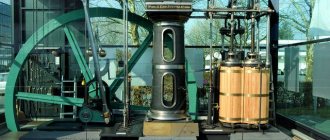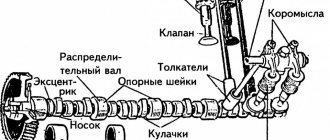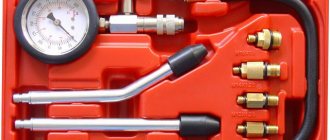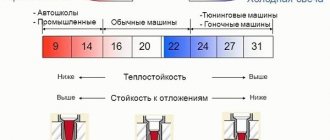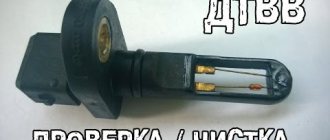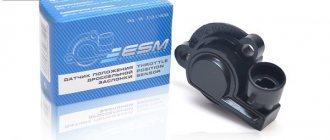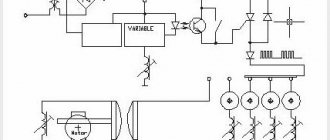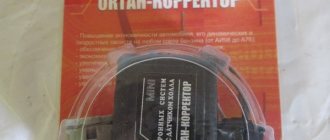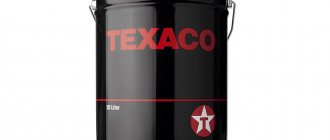Engine classification
Depending on the method of preparing the air-fuel (combustible) mixture, engines are distinguished:
A combustible mixture is a mixture of fuel vapor or combustible gas with air in a ratio that ensures its combustion in the working cylinder of the engine. A flammable mixture is formed in engines during the mixture formation process. It mixes in the combustion chamber with residual combustion products and forms a working mixture.
Mixture formation is the process of preparing a working mixture. In internal combustion engines, mixture formation is distinguished between external and internal.
External mixture formation is the process of preparing the working mixture outside the engine cylinder - in the carburetor (for engines running on liquid, easily evaporating fuel) or in the mixer - for engines running on gas.
Internal mixture formation is the process of preparing the working mixture inside the cylinder. Fuel is supplied to the combustion chamber by a nozzle using a high pressure pump.
In high-speed diesel engines, two methods of mixture formation are used: volumetric and film.
Volumetric mixture formation is a method of forming a combustible mixture in which fuel is converted from a liquid state into a vapor state under the influence of vortex air flows in the combustion chamber.
The film method of mixture formation involves converting fuel from a liquid state into a vapor state in the process of moving a thin layer (film) of fuel along the surface of the combustion chamber under the action of an air flow. For complete combustion of fuel with volumetric mixture formation, it is required that the injectors atomize well and distribute the fuel evenly throughout the volume of the combustion chamber. In diesel engines operating with film mixture formation, fuel is injected by a nozzle onto the surface of the combustion chamber at a small angle to the surface. Then it moves with vortex air currents along the heated surface of the chamber and evaporates. With this method of mixture formation, less stringent demands are placed on the nozzle than with a volumetric one.
For complete combustion of fuel in the engine, a minimum, so-called theoretically necessary, amount of air is required. Thus, the combustion of 1 kg of diesel fuel requires 0.496 kmol of air, and the combustion of 1 kg of gasoline requires 0.516 kmol of air. However, due to imperfections in the mixture formation process, the amount of air contained in the combustible mixture of a running engine may be more or less than indicated.
The ratio of the actual amount of air entering the engine cylinder to the amount of air theoretically required for complete combustion of the fuel is called the excess air coefficient a. It depends on the type of engine, design, type and quality of fuel, mode and operating conditions of the engine. For automobile engines running on gasoline, a = 0.85... 1.3. The most favorable conditions for fuel combustion are created at a = 0.85...0.9. At the same time, the engine develops maximum power. The most economical operating mode is at a = 1.1...1.3. This is a load mode close to full.
The formation of the working mixture in carburetor engines begins in the carburetor, continues in the intake pipes and ends in the compression chamber. In diesel engines, the working mixture is formed in the compression chamber when fuel is injected into it by an injector. Therefore, there will be less time to prepare the working mixture in diesel engines than in carburetor engines, and the quality of preparing the working mixture is worse.
To ensure complete combustion of a unit of fuel entering the cylinder, diesel engines need more air than carburetor engines. In this regard, the excess air coefficient of diesel engines fluctuates at full and close to full load in the range of 1.4...1.25, and at idle it is equal to 5 or more units.
If the working mixture contains less air than is theoretically necessary for complete combustion of the fuel contained in the mixture, then such a mixture is called “rich”. If a>1, i.e., there is more air in the mixture than is theoretically necessary for fuel combustion, then such a mixture is called “lean”.
The higher the quality of mixture formation, the closer the value of a is to unity. For each type of engine, coefficient a has its own values. During operation, the adjustment of the fuel supply equipment is disrupted, the air filters become dirty, and this leads to an increase in hydraulic resistance and a decrease in the amount of air entering the cylinders. In this case, the working mixture is often over-enriched. As a result, the fuel does not burn completely. Together with exhaust gases, their toxic components, such as carbon monoxide (CO), nitrogen oxide and dioxide (NO, N02), are emitted into the atmosphere. They pollute the environment. At the same time, engine efficiency deteriorates. Particularly a lot of carbon monoxide is released when gasoline engines run on a rich mixture. Small amounts of CO are released when diesel engines are idling. This is caused by local over-enrichment of the mixture due to unsatisfactory operation of the fuel equipment.
To reduce environmental pollution, it is necessary to timely and efficiently adjust fuel supply equipment and maintain the air filtration system and gas distribution mechanism.
Based on the method of ignition of the working mixture, engines are distinguished between forced ignition and compression ignition.
In positive ignition engines, the working mixture is ignited by an electric spark that is formed when the piston approaches top dead center (TDC) on the compression stroke. At this point, the compression chamber contains an air-fuel mixture, compressed to 0.9...1.5 MPa and heated to 280...480°C.
Liquid fuel can only burn in a gaseous state. Therefore, it is necessary that the carburetor ensures that the fuel atomizes as finely as possible. The finer the atomization, the larger the total surface of the fuel particles, the shorter the period of time it evaporates. When a spark occurs, only that part of the mixture that is located at the electrodes of the spark plug is ignited. In this zone, the temperature reaches 10,000° C, and the resulting flame spreads at a speed of 30...50 m/s throughout the entire volume of the combustion chamber. The duration of the combustion process is 30...40° crankshaft rotation angle. Angle in degrees of rotation of the crankshaft from the moment of spark formation in the spark plug to TDC. called ignition timing angle f3. The optimal value of the angle φ3 depends on the engine design, operating mode, engine operating conditions and fuel quality.
Diesel engine type
Diesel engines deserve special attention . Their operating principle is based on the ignition of the working mixture during compression. When air is drawn in, the process occurs under high pressure, causing the mixture to spontaneously ignite. After ignition, the piston stroke occurs, which then displaces the exhaust gases.
This type of engine has lower fuel consumption and a small amount of harmful substances in emissions. The efficiency of this power unit is also much higher. Diesel engines now continue to improve and even frost is no longer an obstacle to starting the engine.
Different types of diesel engines have different characteristics that depend on the time of year. These power units do not have an ignition system, because the fuel ignites due to high pressure, which causes the piston to move.
Classification of engines by mixture formation
Internal combustion engines can be classified according to various criteria.
a) stationary, which are used at low- and medium-power power plants, to drive pumping units, in agriculture, etc.
b) transport, installed on cars, tractors, airplanes, ships, locomotives and other transport vehicles.
2. Based on the type of fuel used, engines operating on:
a) light liquid fuel (gasoline, benzene, kerosene, naphtha and alcohol);
The proposed classification applies to internal combustion engines, widely used in the national economy. Special engines (jet, rocket, etc.) are not considered in this case.
b) heavy liquid fuel (fuel oil, diesel oil, diesel fuel and gas oil);
c) gas fuel (generator, natural and other gases);
d) mixed fuel; the main fuel is gas, and liquid fuel is used to start the engine;
e) various fuels (gasoline, kerosene, diesel fuel, etc.) - multi-fuel engines.
3. According to the method of converting thermal energy into mechanical energy, engines are distinguished:
a) piston engines, in which the process of combustion and conversion of thermal energy into mechanical energy occurs in a cylinder;
b) gas turbines, in which the fuel combustion process takes place in a special combustion chamber, and the conversion of thermal energy into mechanical energy occurs on the blades of the gas turbine wheel;
c) combined, in which the process of fuel combustion occurs in a piston engine, which is a gas generator, and the conversion of thermal energy into mechanical energy occurs partly in the cylinder of the piston engine, and partly on the blades of the gas turbine wheel (free-piston gas generators, turbopiston engines, etc.) .
4. According to the method of mixture formation, piston engines are distinguished:
a) with external mixture formation, when the combustible mixture is formed outside the cylinder; All carburetor and gas engines, as well as engines with fuel injection into the intake pipe, operate using this method;
b) with internal mixture formation, when during the intake process only air enters the cylinder, and the working mixture is formed inside the cylinder; Diesels, engines with spark ignition and fuel injection into the cylinder, and gas engines with gas supplied to the cylinder at the beginning of the compression process operate using this method.
5. According to the method of ignition of the working mixture, they are distinguished:
a) engines with ignition of the working mixture from an electric spark (spark ignition);
b) engines with compression ignition (diesels);
c) engines with prechamber-torch ignition, in which the mixture is ignited by a spark in a special small-volume combustion chamber, and further development of the combustion process occurs in the main chamber.
d) engines with ignition of gas fuel from a small portion of diesel fuel ignited by compression - a gas-liquid process.
6. According to the method of carrying out the working cycle, piston engines are divided into:
a) four-stroke naturally aspirated (air intake from the atmosphere) and supercharged (intake of fresh charge under pressure);
b) two-stroke - naturally aspirated and supercharged. A distinction is made between supercharging with a compressor driven by a gas turbine operating on exhaust gases (gas turbine supercharging); boost from a compressor mechanically connected to the engine, and boost from compressors, one of which is driven by a gas turbine and the other by the engine.
7. According to the method of regulation when the load changes, they are distinguished:
a) engines with high-quality regulation, when, due to changes in load, the composition of the mixture changes by increasing or decreasing the amount of fuel introduced into the engine;
b) engines with quantitative control, when when the load changes, the composition of the mixture remains constant and only its quantity changes;
c) engines with mixed regulation, when the quantity and composition of the mixture changes depending on the load.
a) piston engines, which, in turn, are divided: according to the arrangement of the cylinders into vertical in-line, horizontal in-line, V-shaped, star-shaped and with anti-flow cylinders;
according to the location of the pistons: single-piston (each cylinder has one piston and one working cavity), with oppositely moving pistons (the working cavity is located between two pistons moving in the same cylinder in opposite directions), double-acting (there are working cavities on both sides of the piston) ;
b) rotary piston engines, which can be of three types:
the rotor (piston) performs planetary motion in the housing; when the rotor moves between it and the walls of the housing, chambers of variable volume are formed in which the cycle occurs; this scheme was predominantly used;
the body undergoes planetary motion, but the piston is motionless;
The rotor and housing perform a rotational movement - a birotor motor.
9. According to the cooling method, engines are distinguished:
a) with liquid cooling;
Cars are equipped with piston engines with spark ignition (carburetor, gas, fuel injection) and compression ignition (diesels). Some experimental vehicles use gas turbine and rotary piston engines.
Source
The main design differences of the internal combustion engine
If we talk about the main differences in the design of piston engines, various power units are divided into in-line horizontal and vertical according to the arrangement of the cylinders. Engines are also V-shaped, opposed, etc.
There are also single-piston engines, when one cylinder has one piston and a working cavity. In this case, there are also internal combustion engines in which the pistons move oppositely in one cylinder, and the working cavity is located between the two pistons. There are also double-acting motors, in which there are working cavities on both sides of the piston.
Separately, it is worth mentioning rotary piston engines (Wankel engine), which also have different designs. The most common option is where the rotor, which is the piston, moves (planetary motion) in the housing. During such movement, combustion chambers with variable displacement are formed between the rotor and the walls of the engine housing.
We also recommend reading a separate article about the types and types of internal combustion engines. From this article you will learn about the different types of existing internal combustion engines, as well as their distinctive features.
At the same time, there are variants of a rotary engine, where the piston-rotor does not move, and the planetary motion is performed by the internal combustion engine housing. Another type can be considered units in which both the housing and the rotor itself move.
Car engine design, types
An automobile internal combustion engine is a unit consisting of a number of components and parts. It works due to the fact that the fuel-air mixture functions in a combustion chamber closed from the external environment. Once there, the mixture ignites.
Due to the expansion of gases (they, in turn, appear due to the ignition of the mixture), thermal energy is generated. According to the laws of physics, it transforms into a mechanical one, beginning to transmit torque through the transmission to the drive wheels. Based on all these processes, an automobile internal combustion engine operates.
Advantages of internal combustion engines
- Convenience
. It is enough to have a gas station on the road or a can of gasoline in the trunk - and the problem of refueling the engine is easily solved. If the car has an electric motor, charging is not yet available in all places. - High engine refueling speed
. - Long service life
. Modern internal combustion engines easily operate within the period declared by the manufacturer (on average 100-150 thousand kilometers), and some even 300-350 thousand kilometers. However, the world record holder is a mileage of ~4,800,000 km. And there are no extra zeros here. This record was set on the Volvo P1800 engine. The only thing is that during its operation the engine underwent major overhauls twice. - Compactness
. Internal combustion engines are much more compact than external combustion engines.
Classification of aircraft engines
From the time of the first development to the present day, piston and rotary piston internal combustion engines (Wankel) have been produced.
Piston internal combustion engine
The working combustion chamber in piston engines is located inside the cylinder, between the surface of the cylinder head plane (cylinder head) and the bottom of the piston when it is at top dead center (maximum lift of the piston).
Thermal energy is generated using a crank mechanism (crank mechanism), which provides reciprocating movements. The resulting energy as a result of ignition of the mixture presses on the piston, transferring energy to the crankshaft.
Piston engines exist in three variations:
Gasoline carburetor car engine . Through carburetion, the fuel-air mixture is formed outside the combustion chamber (external mixture formation), and is prepared in the carburetor. The mixture is ignited by the spark plug.
Gasoline injector . mixture formation occurs inside the combustion chamber. Fuel is supplied by electronically controlled injectors, which can be installed at the end of the intake manifold or mounted in the cylinder head. The ECU (electronic engine control unit) controls and adjusts the operation of the entire engine.
Diesel engine . Ignition of diesel fuel occurs without the participation of a spark plug, but through air compression, as a result of which the air temperature exceeds the combustion temperature. Fuel injection is carried out by injectors, and the injection pump is responsible for injection under pressure (high pressure fuel pump).
Rotary internal combustion engine
A rotary piston automobile engine works as follows: the working chamber of the engine is oval-shaped, inside which a triangular rotor moves, moving along a planetary trajectory around its axis.
The rotor takes on the function of the piston, crankshaft and timing gear (gas distribution mechanism). The chamber has 4 compartments, each of which has a cycle:
Rotary piston engines have a high efficiency relative to a piston engine, since the friction losses of the former are significantly lower, but the maximum rotor life does not exceed 100,000 km.
Car piston engine design
The simplest internal combustion engine has an in-line arrangement of cylinders. In modern engines there are from 3 to 6. A more compact car engine has a V-shape, that is, the pistons are located at an angle opposite each other.
A V-shaped engine can have 4, 6, 8, 10 and 12 cylinders. There are also in-line VR and W engines; their design is complex, so it is better to study the engine design on an in-line “four”.
The basis of the engine is the cylinder block. Pistons move in these cylinders. At the bottom of the block, the crankshaft is mounted on friction bearings (liners), a connecting rod is attached to it, and a piston is attached to the connecting rod.
This type of assembly is called a crank assembly. Since the crankshaft has, as its name suggests, the shape of a knee, without a connecting rod it would be impossible to ensure the reciprocating movements of the piston.
The design of the connecting rod is made in such a way that its lower part makes oscillatory movements, and the upper part, connected to the piston, does not move in the lateral direction.
The engine piston has three rings: two compression rings and one oil scraper ring. The purpose of the rings is indicated by the name itself: compression rings provide pressure in the cylinder, preventing gases from escaping into the crankcase, and oil scraper rings remove oil from the cylinder walls and dump it into the oil sump.
A pulley is connected to the crankshaft on the front side to ensure the operation of attachments through a belt, as well as the operation of the timing belt if the drive type is belt driven. If the timing belt is of a chain type, then a star is installed on the crankshaft. An additional sprocket on the crankshaft can be installed if the oil pump drive is chain driven.
A flywheel is installed on the rear side of the crankshaft. The flywheel accumulates mechanical energy and transmits it through the transmission to the drive wheels. The flywheel has teeth for connection to the starter.
The top of the cylinders is hermetically covered with a cylinder head, between which a metal gasket is installed. The combustion chamber is located precisely in the cylinder head, and can be spherical or hemispherical in shape, and in diesel engines the combustion chamber is located in the piston recess.
The design of a classic cylinder head includes:
A spring is responsible for returning the valve to its original location, which is covered with a plate and fixed with “crackers”.
Timing drive, most often chain or belt. The chain drive requires plastic dampers and a mechanical or hydraulic tensioner. The timing belt drive has a simple design and includes a belt, an idler pulley and a tensioner.
